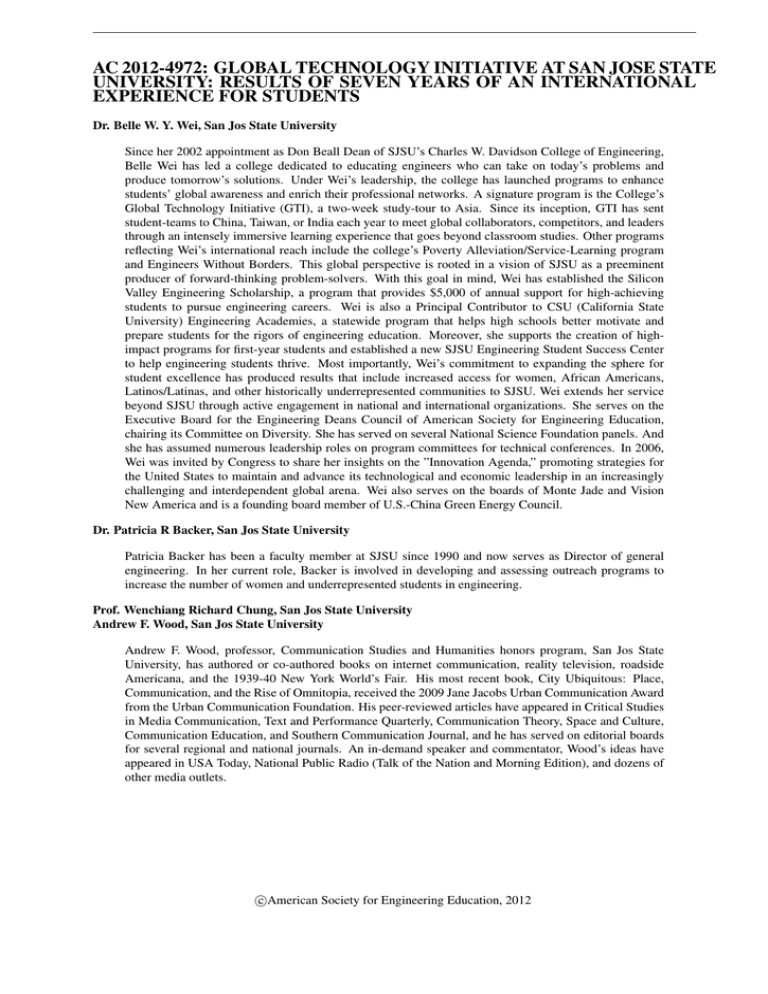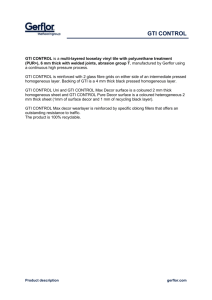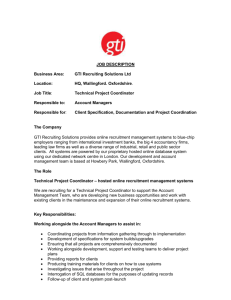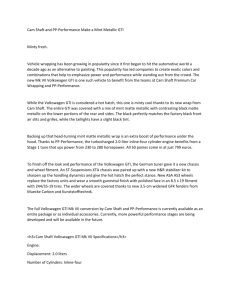Global Technology Initiative at San Jose State University: Results of
advertisement

AC 2012-4972: GLOBAL TECHNOLOGY INITIATIVE AT SAN JOSE STATE UNIVERSITY: RESULTS OF SEVEN YEARS OF AN INTERNATIONAL EXPERIENCE FOR STUDENTS Dr. Belle W. Y. Wei, San Jos State University Since her 2002 appointment as Don Beall Dean of SJSU’s Charles W. Davidson College of Engineering, Belle Wei has led a college dedicated to educating engineers who can take on today’s problems and produce tomorrow’s solutions. Under Wei’s leadership, the college has launched programs to enhance students’ global awareness and enrich their professional networks. A signature program is the College’s Global Technology Initiative (GTI), a two-week study-tour to Asia. Since its inception, GTI has sent student-teams to China, Taiwan, or India each year to meet global collaborators, competitors, and leaders through an intensely immersive learning experience that goes beyond classroom studies. Other programs reflecting Wei’s international reach include the college’s Poverty Alleviation/Service-Learning program and Engineers Without Borders. This global perspective is rooted in a vision of SJSU as a preeminent producer of forward-thinking problem-solvers. With this goal in mind, Wei has established the Silicon Valley Engineering Scholarship, a program that provides $5,000 of annual support for high-achieving students to pursue engineering careers. Wei is also a Principal Contributor to CSU (California State University) Engineering Academies, a statewide program that helps high schools better motivate and prepare students for the rigors of engineering education. Moreover, she supports the creation of highimpact programs for first-year students and established a new SJSU Engineering Student Success Center to help engineering students thrive. Most importantly, Wei’s commitment to expanding the sphere for student excellence has produced results that include increased access for women, African Americans, Latinos/Latinas, and other historically underrepresented communities to SJSU. Wei extends her service beyond SJSU through active engagement in national and international organizations. She serves on the Executive Board for the Engineering Deans Council of American Society for Engineering Education, chairing its Committee on Diversity. She has served on several National Science Foundation panels. And she has assumed numerous leadership roles on program committees for technical conferences. In 2006, Wei was invited by Congress to share her insights on the ”Innovation Agenda,” promoting strategies for the United States to maintain and advance its technological and economic leadership in an increasingly challenging and interdependent global arena. Wei also serves on the boards of Monte Jade and Vision New America and is a founding board member of U.S.-China Green Energy Council. Dr. Patricia R Backer, San Jos State University Patricia Backer has been a faculty member at SJSU since 1990 and now serves as Director of general engineering. In her current role, Backer is involved in developing and assessing outreach programs to increase the number of women and underrepresented students in engineering. Prof. Wenchiang Richard Chung, San Jos State University Andrew F. Wood, San Jos State University Andrew F. Wood, professor, Communication Studies and Humanities honors program, San Jos State University, has authored or co-authored books on internet communication, reality television, roadside Americana, and the 1939-40 New York World’s Fair. His most recent book, City Ubiquitous: Place, Communication, and the Rise of Omnitopia, received the 2009 Jane Jacobs Urban Communication Award from the Urban Communication Foundation. His peer-reviewed articles have appeared in Critical Studies in Media Communication, Text and Performance Quarterly, Communication Theory, Space and Culture, Communication Education, and Southern Communication Journal, and he has served on editorial boards for several regional and national journals. An in-demand speaker and commentator, Wood’s ideas have appeared in USA Today, National Public Radio (Talk of the Nation and Morning Edition), and dozens of other media outlets. c American Society for Engineering Education, 2012 Global Technology Initiative (GTI) Study Program: Results of Seven Years of an International Experience for Students Abstract Prompted by the outsourcing of knowledge-based jobs in Silicon Valley and elsewhere in the United States and by the resulting necessity for students to adapt to and capitalize on the global economy, the College of Engineering at San Jose State University established a one-million dollar Global Technology Initiative Study Program to provide American students with a global perspective. The initiative has sponsored an annual program study tour for 25 undergraduate students on a two-week all-expense-paid study tour to Taiwan/China or India during 2004 to 2011. We reported our 2004 experience at the 2005 ASEE Annual Conference and developed new and improved study programs for 2005-2011. This paper summarizes the programs of the past three years, focusing on program development and assessment, with a brief discussion of student selection and logistics. 1. Purpose of the GTI Program In the globally competitive 21st century, corporations have been aggressive in expanding markets and their workforces across the globe. In order for engineers to thrive in such an environment, they need to understand and prepare for this new reality and to develop skills to navigate it. They, for example, need to have intercultural competency skills for them to work effectively with their global collaborators and customers. To this end, we established the Global Technology Initiative (GTI) program at San José State University (SJSU) in 2004. Its goal is to expand students’ horizons about the opportunities and challenges of a global economy, to expose them to global environmental and energy problems in which technology plays a central role, and to motivate their learning of global issues and different cultures. Providing students a first-hand, immersive learning experience, the GTI comprises a semester-long course that culminates in a two-week study tour to India or China/Taiwan. These destinations are selected because of their strong relationship with Silicon Valley’s information technology companies and their competitive technology industries. Moreover, India and China, each with populations over one billion, have a significant impact on global environmental and energy issues. One distinguishing feature of the GTI study-tour is that it is 100% sponsored; GTI fellows are selected independent of their financial standing. It has been supported by the GTI fund as well as the College's endowment fund of over $22 million. This is a key component of our program as most of our students come from middle-class and working-class families. Value is placed on students’ leadership experience and potential as we expect the GTI fellows to share their learning and influence their peers after their study tour. So, the impact is not limited to those 23-25 GTI fellows we select each year. 2. Evolution of GTI Since 2004, we have sent over 160 GTI fellows to Asia through the GTI program1 2. The first three cohorts (2004-2006) visited Taiwan and China and the next three cohorts visited India (2008-2010), with the most recent cohort visiting Taiwan and China (2011). During this sevenyear period, we have made three programmatic shifts. First, in 2005, we extended the scope of GTI from a focus on the global economy to include environmental and energy concerns, as there had been heightened public interest, and subsequent student interest, in global warming following Al Gore’s highly publicized An Inconvenient Truth. As a result, site visits include not only technology and business locations, but also environmental and energy enterprises. Second, beginning in 2009, we increased the scope of the preparatory course and increased the number of units from one to three. Student feedback from the one-unit class indicated that there was a lack of cultural and social context leaving them ill equipped to deal with the shock of another culture. Therefore, we developed a three-unit course, taught in collaboration with professors from the SJSU Department of History, who are specialized in the history India or China. With more advanced knowledge, the GTI fellows can better appreciate and understand what they encounter during the tour, thereby deepening their learning. Third, we plan to introduce learning modules on developing intercultural competency and global leadership skills for the 2012 cohort so that GTI fellows can better develop their leadership potential. Given the context of globalization, leadership skills start with intercultural competency. 3. Selection of Participants Since the establishment of GTI program in 2004, it was well recognized that the addition of students outside the College of Engineering would add the value to the program; students learning from peers from different majors would experience a host of different viewpoints upon the same object. For the 2011 GTI Program, a two-step screening procedure was developed to evaluate all engineering applicants. Participants selected from outside of College of Engineering (the other six colleges at SJSU) had to go through an internal screening practice. Each college used a different mechanism, directed from their respective Dean’s office. For engineering students, in the first step of the screening process, a rubric was established encompassing categories such as Grade Point Average (GPA) in major and university; global perspective and curiosity about foreign countries (particularly about China and Taiwan) on both a cultural and professional level; service to SJSU student organizations or non-SJSU community organizations; past, current and future leadership positions; communication and interpersonal skills; work experience in engineering fields; and potential for significant learning of globalization. Five faculty members, each possessing numerous years of experience in teaching upper division undergraduate courses and mentoring students, were invited to evaluate the submitted applications based on the aforementioned screening criteria. Approximately one-half of the applicants (31 out of 67) were invited to a face-to-face interview before the final decision was made. In this interview process, a committee consisting of five faculty members was formed. The major task that the committee undertook was to identify the best candidates for the GTI program. Another rubric consisted of seven questions with an emphasis in five areas (communication skills, maturity, preparation for GTI, potential for learning of globalization, and potential contributions after the GTI tour) was formulated. All five areas were quantified based on a ranking scale 1-5 (5 being the best). The best score that a finalist could obtain is 25. After the interview process, the committee tabulated their scores and discussed the interviewees with preferences given to those had demonstrated strong academic records, community leadership, and potential to benefit and disseminate their learning to university community. For the 2011 GTI study program, 23 students were selected: 17 from engineering and 1 student each from the other six SJSU colleges (Applied Sciences and Arts, Business, Education, Humanities and the Arts, Science, and Social Sciences). For the engineering participants, 1 majored in Aviation and Technology, 2 in Chemical and Materials Engineering, 3 in Civil and Environmental Engineering, 2 in Computer Engineering, 3 in Electrical Engineering, 2 in General Engineering (emphasis in Biomedical Engineering), 2 in Industrial and System Engineering, and 1in Mechanical Engineering. All participants, except one graduate student majoring in English, were undergraduate students; most of them were juniors and seniors. 4. Pre-trip student preparation The GTI program, for the first four years, included a one-unit pre-trip acculturation course for the participants. Between 2004 and 2008, the GTI students participated in a one-unit course prior to the trip. Assessment of the students from the GTI 2008 trip indicated that the one-unit course on India failed to prepare GTI fellows for their trip to India. Therefore, beginning with the GTI 2009 program, we increased the scope of the preparatory course from one to three units. The 3unit course was developed and taught in collaboration with professors from the Department of History, who are specialized in the history of India or China. We designed a special section of one of the College’s General Education courses, Tech 198 (Technology and Civilization), to serve as the pre-trip course. Tech 198 satisfies the requirements of SJSU Studies Area V: Culture, Civilization & Global Understanding. This special GTI Tech 198 course focused on the political, social, economic, technological, and cultural history of either China or India, depending on the current year’s focus of GTI. The Spring 2011 GTI course was developed by a SJSU faculty member, Dr. Bruce Reynolds, from the Department of History at SJSU. The Spring 2011 course began with an introduction to the geography of China, followed by a survey of Chinese history. In the latter focus, we devoted one week each to traditional China, technology in Chinese history, China in Revolution (1911-1949), the years of Mao Zedong's rule (1949-1976), and China under Deng Ziaoping's Reforms. Reading assignments included Jung Chang's book Wild Swans: Three Daughters of China, which tells the story of one family's experiences during the revolutionary and Peter Hessler's book Country Driving: A Journey through China from Farm to Factory, based on his travels around the country. We also used several films in this course including The People's Republic of Capitalism, China from the Inside, In Search of China, China Prep, The Genius that Was China, China in Revolution, and Great Leap. The discussions from the assignments focused on societal issues such the urbanrural divide, the role of minorities, and consequences of the "one-child" policy. Dr. Patricia Backer, the Tech 198 course coordinator, presented a class on information technology in China. The course concluded with a session on Taiwan and on China's international relations. Writing assignments were comprised of short essays based on the assigned books and two research papers, one analyzing the relationship between China and India and the other on the effects of the reform program in China and the impact of China's emergence as a global power on the United States. Also, each student chose a major research topic in one of four general areas: culture and people of China, China's economy and entrepreneurship, environmental and health issues in China, and energy and renewable resources in China. Students submitted a major research paper, a personal experience paper, and a personal multimedia project (see section 5 below) after completion of the trip. In Spring 2011, we offered a three-session optional language course for students with little or no knowledge of Mandarin. Over three days (for a total of 12 hours), students engaged in communicative activities while reflecting on cultural connections and cultural differences between China and the U.S. Students were taught about culturally appropriate ways to: exchanges basic greetings, discuss their profession and hobbies, make requests and giver permission, express gratitude and modesty, order goods in a restaurant, and ask for help to deal with emergent situations. In addition to the course and optional language instruction, we included two other activities to prepare the students. One activity was arranged to prepare students for travel logistics. This was conducted in two phases. During the first phase, a representative from SJSU’s International Studies and Affairs Office was invited to the Tech 198 class to discuss the university touring/studying abroad policies and travel guidelines. In the second phase, the GTI program provided students with trip logistics and tour itinerary such as which sites were to be visited and what transportation vehicles were to be used. Along with the tour itinerary, passports, visas, luggage packing, airplane, bus, train tickets, foreign currencies, potential health/safety issues (i.e. recommended vaccinations, water and air pollution concerns, safety practice, and travel accidental insurance) were discussed prior to the departure. The other activity was associated with the trip format and the interconnection developed among the students. To ensure the safety and the efficiency during the trip, the GTI students were divided into five groups; each group was assigned a leader (based on the past travel experience and personal maturity). The group leaders had to report to the GTI faculty the head counts and members’ health conditions at each meeting. This was proven to be highly efficient as there were no GTI students left behind at each activity and shortened the time for assembly. This also helped the faculty to monitor students’ whereabouts and any potential problems. At the end of the tour, all group leaders were awarded a small gift as a token of appreciation for their service to the groups. 5. Multimedia Project An addition to the Spring 2011 GTI course was a self-designed student multimedia project. GTI students were provided a new opportunity to customize elements of their learning through the implementation of a personal media project (PMP). The PMP was developed, coordinated, and evaluated by a communication studies professor who was invited to co-lead the 2011 study tour. The PMP asks students to research and examine items relating to a topic of personal interest during their study tour, and then to produce a brief “media package” (a video, a booklet, a poster, or any other production that can be archived and potentially distributed) about their discoveries upon returning to the U.S. Students were also informed that any “gathering” of artifacts for a PMP must be done in a manner consistent with host-country sensitivities (and common sense). Taking photographs in China, for example, is generally acceptable in most environments. Even so, students were reminded to employ due regard and respect for places in which tourist activities might be regulated or restricted. One initial motivation for the PMP is to reduce the “tunnel vision” experienced by some students who find that the tour’s deep content and fast pace restricts concentration almost solely to host presentations, transportation logistics, and stress management. Even the scheduling of various cultural site-visits risks exacerbating the problem by adding a typical tourist lament: feeling so besieged with over-packaged totalizing environments that one can hardly recall details from the experience. The PMP, therefore, invites students to append a unique agenda to their travels, encouraging them to be more attentive, at least to specific qualities relating to their personal interests. Additionally, the PMP promotes teambuilding, as peers point out potential “finds” that might interest their colleagues. Finally, because the PMP is coordinated by a professor who assisted students in planning, implementation, troubleshooting, and post-processing, participants were inspired to craft their projects thoughtfully and with some regard for professionalism. Reviewing the implementation of this component, one unexpected outcome and two relevant lessons emerged. One surprising benefit of the PMP was its utility in connecting GTI students to a broader audience than might be found in most classrooms. To illustrate, students who had completed the 2011 program were asked to present their projects at a celebratory banquet attended by all of the SJSU deans, the SJSU President, and program sponsors. The multimedia array of PMPs (each presented before the banquet in a poster-session format) demonstrated an eclectic collection of student interests that ranged from Beijing transportation practices to Chinese environmental strategies to Asian shoe styles. Over a half-hour period, students’ informal conversations with dinner guests allowed for a quality of engaging exchange and oneto-one connection that can never be found in a formal presentation. Subsequent comments by attendees about their memories of the dinner confirmed the PMP’s favorable impact. Anticipating future development of this project, one finds the potential for similar interactions to deepen students’ engagement while building their communication skills and, at the same time, enhancing a personalized method for conveying the value of this program to faculty, administrators, and even donors. Toward that end, two considerations must be added. First, while students are clearly and comfortably positioned as consumers of media, many need specialized guidance in matters of production, especially concerning aesthetic considerations. Second, though students may express little difficulty in selecting a topic prior to the study tour, they should be supported in their choices to reframe their projects in light of new discoveries on-site. For the Spring 2012 GTI program, we are continuing the PMP assignment. 6. Site visits in China and India In order to stimulate students’ interest and maximize their learning, a list of site visits including companies, universities, and historical sites were carefully identified. This selection was partially based on the research topics such as the history and culture of China/India, the economy in China/India, the information technology in China/India, and energy and infrastructure in China/India with respect to the environmental is pre-assigned to GTI participants before their departure. As a result, the chosen sites exhibit the following themes: Manufacturing facilities--e.g., a vacuum furnace manufacturing plant, a flat panel LCD plant, and a water bottle manufacturing plant Energy research/operation facilities--e.g., a nuclear power plant, an automotive manufacturing plant, an electric car research facility Information technology facilities--e.g. biomedical devices/diagnosis systems, an Internet search company, a software company Semiconductor facilities--e.g. a semiconductor fab, computer/server companies, a computer graphic design company Cultural Sites. In China, we visited the Great Wall, the Forbidden City and Tiananmen Square. In India, we visited the Taj Mahal, Agra Fort, and the Mani Bhawan. Top-Tier Universities--e.g. Tsinghua University, Tongji University, Zhejiang University, National Central University The GTI 2010 program began with an intensive three-unit course on India’s culture and influence on technology and culminated with a two-week long, five-city tour of India. The delegation consisted of twenty-two SJSU students and a couple of faculty members. The cities toured were Mumbai, Pune, Hyderabad, Agra and Delhi and the delegation had the opportunity to visit seven hi-tech companies, two film and television studios, two of India’s largest manufacturing companies, a small light bulbs manufacturing plant, an animation studio, and the Indian Institute of Technology, Bombay (IIT Bombay). Despite a busy schedule, the students were able to squeeze in some cultural visits including sightseeing and city tours. The GTI 2011 delegation consisted of 23 SJSU students and two faculty members who toured three cities in China and four cities in Taiwan for a total of two weeks. The cities visited were Beijing, Shanghai and Hangzhou in China and Taipei, Keelung, Hsinchu and Taoyuan in Taiwan. Both American and Chinese leading companies (e.g. IBM and Baidu) were selected to illustrate the differences in culture, management, and the competitive positions of those organizations. Industrial parks and government-sponsored research institutes (such as Zhongguancun Science Park in China and Industrial Technology Research Institute in Taiwan) were included to underscore the government’s role in promoting and developing key industries. As such, companies visited covered a broad array of engineering disciplines, ranging from semiconductors to automobile research and from nuclear power to bio-medical devices. GTI delegates were encouraged to ask questions during and after the host presentations; these activities were hosted by individuals within the Silicon Valley or SJSU network (e.g., SJSU alumni working in Taiwan and China or American expatriates with strong ties to Silicon Valley). In this case, C-3-China (an energy-environmental control company based in Shanghai’s Pu Dong Industrial Park) was presented by a former SJSU graduate. In the spirit of inspiring the students with the greatest engineering accomplishments, several world famous buildings and transportation systems were toured. For example, students visited the National Center for the Performing Arts to view the magnificent architectural structure, the Taipei Financial Center (Taipei 101) to experience the world’s fastest elevator to the top of the Taiwan’s tallest building, and the high speed train between Shanghai and Hangzhou to feel the speed of 400 kilometer per hour. In addition, students had a chance to tour historical and cultural sites such as the Great Wall, the Forbidden City, Temple of Heaven, Tiananmen Square, and the 2008 Olympic sites (Beijing National Stadium, also known the Bird's Nest; Water Cube). Overall, the tour of Beijing, Shanghai, Hangzhou in China and Taipei, Keelung, Hsinchu and Taoyuan in Taiwan gave students ample opportunities to visualize the challenges of Chinese economics, politics and society. This also provided a great opportunity for students to grapple with the contrasts between the East and the West, thereby allowing them to experience contrasting aspects of globalization. The distinctness and uniqueness of Chinese history and culture have piqued many of the students’ interest. 7. Student Feedback After the 2011 GTI study tour, we surveyed students to determine their motivation for applying, their perspectives of the class and study tour, and how this program impacted their personal and professional goals. 20 students responded to our survey (87% response rate); 12 of the respondents were female (60%) and most of them were between the ages of 20 and 24. The ethnicity data for the respondents is displayed in Figure 1. Surprisingly, 15 students (75%) indicated that they had traveled abroad before going on the GTI study tour. When asked which countries they visited, their responses included Central America, South America, Europe, and Asia. The time spent abroad ranged from one week to ten years with a median time of three weeks. Figure 1. Ethnicity of the GTI Survey Respondents As described above, the GTI Tech 198 course provides an overview on the culture, history, business, and technology of China or India. The GTI 2011 students indicated that they made significant learning gains in each of the four major subject areas. The survey presented students with a 6-point likert scale (no gains, little gain, moderate gain, good gain, great gain, and not applicable) for each of the subject areas. As indicated in Figure 2 below, all students selected between moderate, good, or great gains. The most substantial gains were made in the areas of history and cultural perspective. Figure 2. Learning gains pertaining to the four subject areas in the 2011 GTI course In discussing the study tour, the students had many positive comments with a wide range of responses. One student wrote, “I liked the opportunities to visit local and international companies and speak with high-ranking representatives.” Another student said, “I liked the fact that we were able to talk to the students at the universities and hear their perspectives. Also, I liked being able to talk to various people in China, from professionals to students to normal people.” Most of the students said they gained a new perspective on the culture of China and that they most enjoyed visiting historical and cultural sites. An analysis of the reflective essays from 2009 to 2011 reveals that many students experience culture shock; this became a prominent theme in their reflective papers completed after their trips. Negative comments about the study tour focused primarily on scheduling logistics, as many students felt the pace of the trip was exhausting. As one student explained it, “[I did not enjoy] getting up at 6 a.m. basically every day. We would leave real early, and none of us could ever get enough rest. This impacted us every following day until company visits weren’t so bearable.” Given the ambitious schedule of the study tour, we were not surprised by these responses. However, these comments will inform our scheduling of forthcoming GTI study tours. Students indicated that, as a result of the GTI study tour, their attitudes toward the Asia Pacific region have been positively affected and they have set new goals for their future. Among the 20 respondents, 90% of the students identified with the statement “I became aware of the importance of interpersonal and communication skills for a successful career in the United States;” 80% identified with the statement, “I learned how to communicate more effectively with people in China and Taiwan;” and 70% identified with the statement, “I realized the importance of innovation and entrepreneurship.” Three students (15%) indicated that they decided to attend graduate school as a result of the GTI study tour. 8. Publicizing the Program Gaining from the experience of previous years, the GTI program has employed multiple methods to publicize its opportunities and findings, using a multimedia approach that includes the maintenance of a website, the production of a post-tour colloquium (comprised mainly of student-led group presentations), and the distribution of a professionally rendered “yearbook.” These communications, augmented by various other techniques, such as targeted emails and classroom pitches, have proven their value as tools that inspire participation and meaningful reflection. Yet GTI leaders have also found that unscripted student-to-student communication may be the most profound motivator of future involvement and success. For that reason, student participants are invited to become program evangelists upon the conclusion of their study tours, contributing their energies to recruit potential candidates, strengthen the selection process, and offer their voices to help convey the impact of GTI upon their personal and professional lives. Adding to GTI’s publication efforts, the program commissioned the production of a documentary video in 2011, securing the expertise of the same communication studies professor, Dr. Andy Wood, who initiated the Personal Media Project. Importantly, the video offers more than the portrayal of one particular study tour. Interviews with students, hosts, and other stakeholders highlight broader themes, including the need for global awareness, the opportunities for transnational cooperation, and the practicalities of participation in a program known for close quarters and packed schedules. The video seeks to share a compelling narrative at a programmatic level. This documentary can be repurposed for multiple audiences. The strategic inclusion or exclusion of certain elements enables planners to package an invitational pitch for student applicants, a program summary for administrators, and a persuasive appeal for funding agencies, each receiving a customized video that draws from the same raw materials. Of course, any documentary will require minor updates as participants and procedures change. One might presume a roughly three-year shelf life for the current project and anticipate the production of an entirely revised documentary when the program shifts its attention to a new geographical region (potentially a return to India, maybe tours of South Korea or Brazil). Even then, though, the 2011 version will be useful as an archive of the program’s success. 9. Emerging focus Since completing their first tour in 2004, the GTI coordinators have expanded their attention from student awareness of technological innovation around the Pacific Rim to a more comprehensive focus on global leadership. Even so, and especially in comparison to the many extant investigations into this topic3 4 5 6, GTI proposes a relatively basic definition of global leadership: those qualities necessary to advance a strategic plan when the diversity of contributor backgrounds, perspectives, and abilities stretch beyond a national framework. Environments that require that kind of global leadership include international project-groups, especially those whose participants collaborate across asynchronous workspaces (the very kinds of working environments in which future engineers are expected to thrive). As such, global leadership requires more than technical excellence on an individual level; it calls for a measure of intercultural communication competence such that one may be flexible (indeed, comfortable and confident) when sharing ideas, projects, and experiences with colleagues who share a world of difference. This notion of global leadership also assumes a necessarily high degree of personal and ethical engagement, as well as sufficient clarity of communication and depth of understanding when entering a workplace composed of differing perspectives. Accordingly, this approach complicates traditional leadership models (e.g., the delegation of rewards and punishments, the command of specialized knowledge, the distribution of limited resources, and other approaches found in the literature7) by connecting even the most apparently functional problems, engineering or otherwise, to inevitably global issues of environmental sustainability, humane application, and social justice. While still an emerging component of GTI deliberation, this perspective on global leadership will shape coordinators’ efforts as they revise curricula and design future study tours. 10. Implications and Next Steps GTI demonstrates a resolve to gather lessons from each year for the purpose of programmatic growth and improvement. As evidenced in this report, the program gathers a substantial degree of post-tour research that stretches from informal after-action reports to thorough surveys of student perceptions and outcomes. Guided by this sort of data, program leaders observe two specific challenges that must be addressed over the next three-year cycle: an obligation to collect more longitudinal data about student outcomes and a need to more effectively inculcate the goals of global leadership and intercultural competence among program stakeholders. Collecting supplementary longitudinal information means extending data collection beyond the period directly before, during, and after the tour. Since the number of program participants has exceeded 125 students since 2004, research should expand to include the post-graduation perspectives of these alumni. Consequently, coordinators employ quantitative and qualitative techniques to determine practical links between GTI participation and various measures of personal and professional success. Two primary questions are: (1) To what degree does the program produce meaningful changes in beliefs, attitudes, values, and/or behaviors? (2) What lessons can be gleaned for future study tours from graduates whose perspectives differ from those held by program coordinators? Doubtlessly, this research will prove to be instrumental as GTI strives to achieve its global vision. At the same time, efforts to inculcate the goals of global leadership and intercultural competence require a more targeted and integrated array of strategies at multiple levels, each designed to convey a common message about the need for engineers to bring a personal and ethical awareness to both their projects and their interpersonal interactions. This step calls for program coordinators to plan more precisely in student recruitment and selection, course curricula, program planning, and on-site implementation. This step also needs coordinators to strengthen their connections with allied subject matter experts in communication, business, and the humanities. More than adding a catchphrase or some survey questions, the work required for students to acquire the strategies and values of global leadership demands sufficient resource support, renewed team-building and meaningful assessment: necessary components for a program hoping to showcase a college (and campus) commitment to helping students prepare for 21st century realities. For the Spring 2012 GTI program, we have included a two-day workshop on global leadership. By including this workshop, we expect students to develop a global mindset, develop intercultural communication, interact with multicultural teams and prepare them for a lifetime of global leadership. This new workshop will be held on two Saturdays and is required for students who expect to go on the trip. The global leadership workshop must be taken in conjunction with the special section of Technology and Civilization course specifically designed for GTI participants. Overall, the SJSU GTI program has been very successful and has met the objectives set for it. Embedding continuous assessment and improvement into this program has allowed us to adapt to changes and provide the participants with an intensive global experience. Bibliography 1 2 3. 4 5 6 7 Wei, B. W. Y. &Tsao, J., “Studying Offshoring through a Study-Tour of Taiwan and China,” Proceedings of the 2005 American Society for Engineering Education Annual Conference & Exposition, June 2005, Portland, Oregon. Wei, B. W. Y. &Tsao, J., “Global Technology Initiative Study-Tour to Asia at XXX University,” Proceedings of the 2007 American Society for Engineering Education Annual Conference & Exposition, June 2007, Honolulu, Hawaii. De Graaff, E. &Ravesteij, W. (2001). Training complete engineers: Global enterprise and engineering education. European Journal of Engineering Education, 26(4), 419-427. Farr, J.V. (1997). Leadership development for engineering managers.Journal of Management in Engineering, 13(4), 38-41. Dudertadt, J.J. (2010). Engineering for a changing world. In D. Grasso & M. B. Burkins'sHolistic engineering education: Beyond technology (pp. 17-36). New York: Springer Science+Business Media. Taverneya, T.D. &Rendlemanb, J. D. (2011). Engineering global leadership. Astropolitics, 9(2-3), 119-139. Turner, R.J. & Müller, R. (2005). The project manager's leadership style as a success factor on projects: A literature review. Project Management Journal, 36(2), 49-61.





